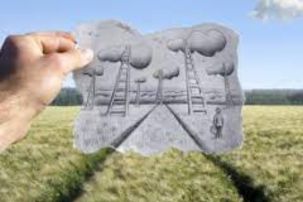Lesson summary
In this activity students will create artworks based on the ‘Pencil vs Camera’ series by Ben Heine. Students will use their own nature photo and create a cartoon image to overlay this photo. Students will present their works to the class for discussion.
Learning intentions:
Students will...
- recognise that there are multiple forms of environmental art
- understand that materials and practices are as important to creating art as the message and intention of the art.
Lesson guides and printables
Lesson details
Curriculum mapping
Australian Curriculum content descriptions:
Years 5 & 6 Visual Arts:
- Explore ideas and practices used by artists, including practices of Aboriginal and Torres Strait Islander artists, to represent different views, beliefs and opinions (ACAVAM114)
- Develop and apply techniques and processes when making their artworks (ACAVAM115)
- Plan the display of artworks to enhance their meaning for an audience (ACAVAM116)
General capabilities: Critical and creative thinking, Ethical understanding.
Time required: 2 x 48 mins
Level of teacher scaffolding: Medium – oversee activity and facilitate discussion
Resources required
- Internet access
- Access to library
- Student worksheet
Additional info
Artist used in this resource:


Welcome back!
Don't have an account yet?
Log in with:
By signing up to Cool.org you consent and agree to Cool's privacy policy to
store, manage and process your personal information. To read more, please see
our privacy policy here(Opens in new tab).
Create your free Cool.org account.
Many of our resources are free, with an option to upgrade to Cool+ for premium content.
Already have an account?
Sign up with:
By signing up to Cool.org you consent and agree to Cool's privacy policy to
store, manage and process your personal information. To read more, please see
our privacy policy here(Opens in new tab).